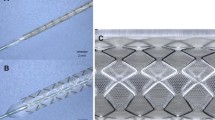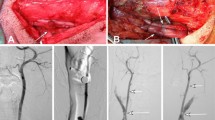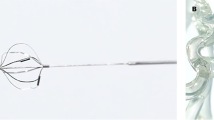Abstract
Treatment of large (diameter 12–25 mm) or giant (diameter >25 mm) cerebral aneurysms with a broad neck in the cranio-cervical area is difficult and carries relatively high risks, even with surgical and/or endovascular methods. To this end, we have been developing a high-performance, self-expanding stent graft which consists of a commercially available NiTi stent (diameter 5 mm, length 20 mm) initially covered with a thin microporous segmented polyurethane membrane fabricated by the dip-coating method. Micropores are then created by the excimer laser ablation technique, and the outer surface is coated with argatroban. There are 2 types of micropore patterns: circular-shaped pore type (pore: diameter 100 μm, opening ratio 12.6%) and the bale-shaped pore type (pore: size 100 × 268 μm, opening ratio 23.6%). This self-expanding stent graft was tested on side-wall aneurysms of both canine carotid arteries that were experimentally induced using the venous pouches from the external jugular veins, with the self-expanding stent graft on one side and a bare self-expanding stent on the other side. All carotid arteries were patent and free of marked stenosis after 1 month. All aneurysms were occluded by stent grafts, while patent in those treated with bare stents. Histologically, the stent grafts with bale-shaped micropores and a high opening ratio were associated with less intimal hyperplasia (187 ± 98 μm) than the bare stents (341 ± 146 μm) or the stent grafts with circular micropores and a low opening ratio (441 ± 129 μm). A pore ratio of 23.6% was found to control intimal growth.




Similar content being viewed by others
References
Cragg AH, Dake MD. Treatment of peripheral vascular disease with stent-grafts. Radiology. 1997;205:307–14.
Palmaz JC. Review of polymeric graft materials for endovascular applications. J Vasc Interv Radiol. 1998;9:7–13.
Nishi S, Nakayama Y, Ishibashi-Ueda H, Matsuda T. Occlusion of experimental aneurysms with heparin-loaded, microporous stent grafts. Neurosurgery. 2003;53:1397–405.
Nishi S, Nakayama Y, Ishibashi-Ueda H, Okamoto Y, Kinoshita Y. High performance self-expanding stent graft; development and application to experimental aneurysms. J Artif Organs. 2009;12:35–9.
Li MH, Li YD, Fang C, Gu BX, Wang W, Cheng YS, Wang YL, Gao BL, Zao JG, Wang J, Li M. Endovascular treatment of giant or very large intracranial aneurysms with different modalities: analysis of 20 cases. Neuroradiology. 2007;49:819–28.
Xue L, Greisler HP. Biomaterials in the development and future of vascular grafts. J Vasc Surg. 2003;37:472–80.
Farrar DJ, Litwak P, Lawson JH, Ward RS, White KA, Robinson AJ, Rodvien R, Hill JD. In vivo evaluations of a new thromboresistant polyurethane for artificial heart blood pumps. J Thorac Cardiovasc Surg. 1988;95:191–200.
Giancario M, Mirko DO, Lacono C, Rozzanigo U, Serio G, Procacci C. Gastrointestinal artery stamp haemorrhage following pylorus-sparing whipple procedure: treatment with covered stents. Dig Surg. 2002;19:237–40.
Kikumoto R, Tamao Y, Tezuka T, Tonomura S, Hara H, Ninomiya K, Hijikata A, Okamoto S. Selective inhibition of thrombin by (2R, 4R)-4-methyl-1-[N2-[(3-methyl-1, 2, 3, 4-tetrahydro-8-quinolinyl) sulfonyl]-l-arginyl]]-2-piperidinecarboxylic acid. Biochemistry. 1984;23:85–90.
Kumada T, Abiko Y. Comparative study on heparin and a synthetic thrombin inhibitor no. 805 (MD-805*) in experimental antithrombin III-deficient animals. Thromb Res. 1981;24:285–98.
Imanishi T, Arita M, Hamada M, Tomobuchi Y, Hano T, Nishio I. Effects of locally administration of argatroban using a hydrogel-coated balloon catheter on intimal thickening induced by balloon injury. Jpn Circ J. 1997;61:256–62.
Richey T, Iwata H, Oowaki H, Uchida E, Matsuda S, Ikada Y. Surface modification of polyethylene balloon catheters for local drug delivery. Biomaterials. 2000;21:1057–65.
Vinuela F, Duckwiler G, Mawad M. Guglielmi detachable coil embolization of acute intracranial aneurysms: perioperative anatomical and clinical outcome in 403 patients. J Neurosurg. 1997;86:475–82.
Ross IB, Weil A, Piotin M, Moret J. Endovascular treatment of distally located giant aneurysms. Neurosurgery. 2002;47:1147–52.
Mordasini P, Schroth G, Guzman R, Barth A, Seiler RW, Remonda L. Endovascular treatment of posterior circulation cerebral aneurysms by using Guglielmi detachable coils: a 10-year single center experience with special regard do technical development. AJNR Am J Neuroradiol. 2005;26:1732–8.
Fiorella D, Albuquerque FC, McDougall CG. Durability of aneurysm embolization with matrix detachable coils. Neurosurgery. 2006;58:51–9.
Magoufis GL, Vrachliotis TG, Stringaris KA. Covered stents to treat partial recanalization of Onyx-occluded giant carotid aneurysm. J Endovasc Ther. 2004;11:742–6.
Ahn JY, Han IB, Kim TG, Yoon PH, Lee YJ, Lee BH, Seo SH, Kim DI, Hong CK, Joo JY. Endovascular treatment of intracranial vertebral artery dissection with stent placement or stent-assisted coiling. AJNR Am J Neuroradiol. 2006;27:1514–20.
Gallas S, Pasco A, Cottier JP, Gabrillargues J, Drouineau J, Cognard C, Herbreteau D. A multicenter study of 705 ruptured intracranial aneurysms treated with Gugliemi detachable coils. AJNR Am J Neuroradiol. 2005;26:1723–31.
Malisch TW, Guglielmi G, Vinuela F, Duckwiller G, Goin YP, Martin N, Frazee J. Intracranial aneurysms treated with Guglielmi detachable coils: midterm clinical results in a consecutive series of 100 patients. J Neurosurgery. 1997;28:219–39.
Geremia G, Brack T, Brennecke L, Haklin M, Falter R. Occlusion of experimentally created fusiform aneurysms with porous metallic stents. AJNR Am J Neuroradiol. 2000;21:739–45.
Krings T, Busch B, Sellhaus B, Drexler AY, Bovi M, Hermanns-Sachweh B, Scherer K, Gilsbach JM, Thron A, Hans FJ. Long-term histological and scanning electron microscopy results of endovascular and operative treatments of experimentally induced aneurysms in the rabbit. Neurosurgery. 2006;59:911–24.
Asahara T, Bauters C, Pastore CJ, Keamey M, Rossow S, Bunting S, Ferrara N, Symes JF, Isner JM. Local delivery of vascular endothelial growth factor accelerates re-endothelialization and attenuates intimal hyperplasia in balloon-injured rat carotid artery. Circulation. 1995;91:2793–801.
Van Belle E, Maillard L, Tio FO, Isner JM. Accelerated endothelialization by local delivery of recombinant human endothelial growth factor reduces in-stent intimal formation. Biochem Biophys Res Commun. 1997;235:311–6.
Nishi S, Nakayama Y, Ueda H, Ishikawa M, Matsuda T. A new stent graft with thin walled controlled micropored polymer covering. Intervent Neuroradiol. 2000;6[Suppl 1]:175–80.
Chuapetcharasopon C, Wright KC, Wallace S, Dobben RL, Gianturco C. Treatment of experimentally induced atherosclerosis in swine iliac arteries; a comparison of self-expanding and balloon-expanded stents. Cardiovasc Intervent Radiol. 1992;15:143–50.
Waller BF, Orr CM, Pinkerton CA, Van Tassel JW, Pinto RP. Morphologic observation late after coronary balloon angioplasty: mechanisms of acute injury and relationship to restenosis. Radiology. 1990;174:961–7.
Li MH, Zhu YO, Fang C, Wang W, Zhang PL, Cheng YS, Tan HO, Wang JB. The feasibility and efficacy of treatment with a Willis covered stent in recurrent intracranial aneurysms after coiling. AJNR Am J Neuroradiol. 2008;29:1395–400.
Serruys PW, Strauss BH, Beatt KJ, Bertrand ME, Puel J, Rickards AF, Meier B, Goy JJ, Vogt P, Kappenberger L. Angiographic follow-up after placement of a self-expanding coronary artery stent. N Engl J Med. 1991;324:13–7.
Flugelman MY, Virmani R, Leon MB, Bowman RL, Dichek DA. Genetically engineered endothelial cells remain adherent and viable after stent deployment and exposure to flow in vitro. Circ Res. 1992;70:348–54.
Kusaba A, Fischer CR, Matulewskin TJ, Matsumoto T. Experimental study of the influence of porosity on development of neointima in Goa Tex grafts: a method to increase long-term patency rate. Am Surg. 1981;47:347–54.
Schürmann K, Haage P, Meyer J, Vorwerk D, Klosterhalfen B, Großkortenhaus S, Hartmann J, Kulisch A, Günther RW. Comparison of two stent-grafts with different porosity: in vivo studies in a sheep model. J Vasc Interv Radiol. 2000;11:493–502.
Golden MA, Hanson SR, Kirkman TR, Schneider PA, Clowes AW. Healing of polytetrafluoroethylene arterial grafts is influenced by graft porosity. J Vasc Surg. 1990;11:838–45.
Clowes AW, Zacharias RK, Kirkman TR. Early endothelial coverage of synthetic arterial grafts: porosity revisited. Am J Surg. 1987;1553:501–4.
Boretos JW, Pierce WS. Segmented polyurethane: a new elastomer for biomedical applications. Science. 1967;158:1481–2.
Grasel TG, Cooper SL. Surface properties and blood compatibility of polyurethaneureas. Biomaterials. 1986;7:315–28.
Szycher M, Siciliano AA, Reed AM. Polyurethanes in medical devices. Med Des Mater. 1991;1:18–25.
Horita N, Tomita H, Takamuro M, Fuse S, Tsutsumi H. Development of a reexpandable covered stent for children. Catheter Cardiovasc Interv. 2006;68:727–34. (discussion p. 735)
Müller-Hülsbeck S, Walluscheck KP, Priebe M, Grimm J, Cremer J, Heller M. Experience on endothelial cell adhesion on vascular stents and stent-grafts: first in vitro results. Invest Radiol. 2002;37:314–20.
Matsuda T, Nakayama Y. Surface microarchitectural design in biomedical applications; in vitro transmural endothelialization on microporous segmented polyurethane films fabricated using an excimer laser. J Biomed Mater Res. 1996;31:235–42.
Li MH, Gao BL, Wang YL, Fang C, Li YD. Management of pseudoaneurysms in the intracranial segment of the internal carotid artery with covered stents specially designed for use in the intracranial vasculature: technical notes. Neuroradiology. 2006;48:841–6.
Krings T, Hans FJ, Möller-Hartmann W, Brunn A, Thiex R, Schmitz-Rode T, Verken P, Scherer K, Dreeskamp H, Stein KP, Gilsbach JM, Thron A. Treatment of experimentally induced aneurysms with stents. Neurosurgery. 2005;56:1347–60.
Zhong H, Matsui O, Xu K, Ogi T, Okuda M, Liu Y, Sanada J, Sun C. Partially covered stent-graft implantation in rabbit aorta: a new model to investigate bioactive stent-grafts in small animals. J Endovasc Ther. 2009;16:154–60.
Author information
Authors and Affiliations
Corresponding authors
Rights and permissions
About this article
Cite this article
Nishi, S., Nakayama, Y., Ishibashi-Ueda, H. et al. Development of microporous self-expanding stent grafts for treating cerebral aneurysms: designing micropores to control intimal hyperplasia. J Artif Organs 14, 348–356 (2011). https://doi.org/10.1007/s10047-011-0581-9
Received:
Accepted:
Published:
Issue Date:
DOI: https://doi.org/10.1007/s10047-011-0581-9




